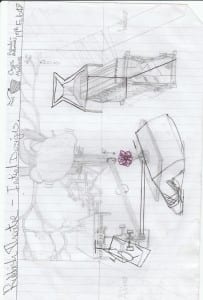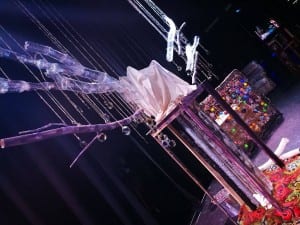As the rehearsals have progressed, so too has the understanding and themes of our performance:
A man who rides a bike, who lives in a mad world and tends to a charming flower.
The introduction of the flower has helped me to make clear scenographic ideas, ideas which will be transformed into a dazzling, mad set that holds the meaning to our show, If an Orchid Was All You Had. Here is my initial set design, where all mistakes have been gone over with a pen (Further designs of each piece can be found in the technical documents section of this blog):
(Initial set design from 19th February. Crawford, 2017)
Nature has become a key theme within my set design, which reflects the central character of The Man and his obsession with an orchid. Nature also has the clearest cycle of life, therefore creating a large central tree as part of the set seemed only natural. A tree where The Man’s madness comes to life and his life, as he knows it, comes to an end. A tree formed out of our everyday, cycles of life.
Components of the tree:
Garden/Base – Half a wallpapering table, some extra bits of scrap wood, floral carpet (for the grass)
Flowers in garden – Bottle tops, ring pulls off drinks cans and unwanted sticks of glue
Trunk – 10 columns of food and drinks cans
Canopy/Top – Other half of the wallpapering table, some extra bits of scrap wood
Branches – Drinks bottles, cupboard tubing and the bought materials of tape and string
Fruits – Tops of food cans (they look just like apples)
(Finished Organ bike for If an Orchid Was All You Had. Image taken by Pearson, J. on Monday 22nd May 2017.
Rubbish Theatre, 2017)
The tree is central as it is the physical connection to The Man’s inner psyche and madness. The trees roots are damaged, industrial wire that provide the explicit connection to The Man when he’s on the bike. This results in the creatures also having an explicit connection to The Man, as they only enter and exit the stage from the tree. This also aids in sight lines in the audience as we are performing in a thrust format. Robert Klingelhoefer points out that, ‘Designing for the thrust stage, the designer must be very aware of the range of sightlines and create a variety of positions that will allow the director to place the actor at different angles to the audience’ (Klingelhoefer, 2009, 122).
The interconnection between the set and the creatures on stage means there has to be a connection with the materials and aesthetics used in the costumes. Working closely with Aiden Clark, our costume designer, it became clear that this crossover of set and costume is a very important part of creating a coherent atmosphere and world for the audience to be absorbed in.
A design choice of using the same materials for the tree’s canopy and the creature’s costumes was finalised, creating the desired meaning and effect that the creatures are a product of the tree and the tree is an extension of The Man, therefore giving the creatures a material entrapment to The Man on the bike.
References:
Klingelhowfer, R. (2017) The Craft and Art of Scenic Design: Strategies, Concepts, and Resources. Oxon: Routledge.
Rubbish Theatre. (2017) If an Orchid Was All You Had. [Performance] Jacob Kay (dir.) Lincoln: Lincoln Performing Arts Centre, 22nd May.


